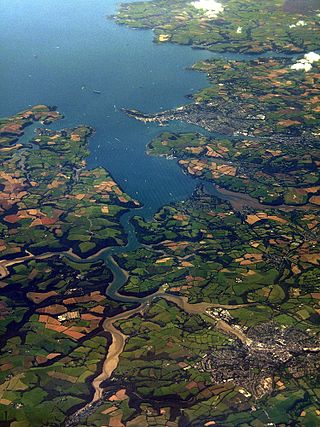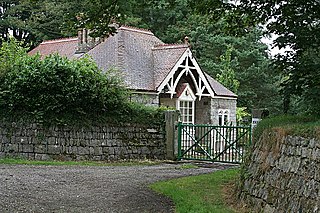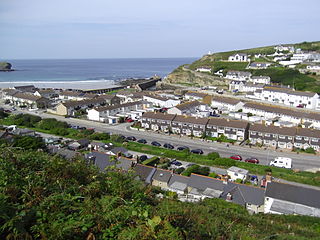
St Levan is a civil parish in Cornwall, England, United Kingdom. The parish is rural with a number of hamlets of varying size with Porthcurno probably being the best known. Hewn out of the cliff at Minack Point and overlooking the sea to the Logan Rock is the open-air Minack Theatre, the inspiration of Rowena Cade in the early 1930s.
Sheriffs and high sheriffs of Cornwall: a chronological list:

Gwennap is a village and civil parish in Cornwall, England. It is about five miles (8 km) southeast of Redruth. Hamlets of Burncoose, Comford, Coombe, Crofthandy, Cusgarne, Fernsplatt, Frogpool, Hick's Mill, Tresamble and United Downs lie in the parish, as does Little Beside country house.


The Vyvyans are a prominent Cornish family who were members of Parliament, baronets, and landowners in Penwith and Kerrier since the 15th century. The Vyvyan family have held the large Trelowarren Estate in the parish of Mawgan-in-Meneage in west Cornwall for nearly 600 years. They moved to Trelowarren in 1427 from Trevegean, St. Buryan when they acquired Trelowarren through marriage to the daughter of Honora Ferrers, heiress to the estate of the previous owner, Richard Ferrers. Trelowarren's first garden is recorded in 1428. In the English Civil War (1642-1651) the Vyvyans were royalist supporters. Sir Richard Vyvyan (1613-1724), 1st Baronet, was given a large equestrian portrait of King Charles I (1600-1649), a copy of the famous painting by Anthony van Dyck, by King Charles II (1630-1685) in recognition of his support.

There have been twenty one baronetcies created for persons with the surname Williams, eight in the Baronetage of England, three in the Baronetage of Great Britain and ten in the Baronetage of the United Kingdom. Only six of the creations are extant as of 2017.
Sir Frederick Martin Williams, 2nd Baronet was a politician in the United Kingdom. He was Conservative Member of Parliament (MP) for Truro in Cornwall from 1865 until his death in 1878.
Michael Williams was a mining entrepreneur and politician, the MP for West Cornwall from 19 July 1853 until his death in June 1858.
Great Cornish Families: A History of the People and Their Houses is a book by Crispin Gill, published in 1995. A second edition was published in 2011 (ISBN 978-0-85704-083-1). Crispin Gill, at the time of the book's publication, lived in Plymouth and was assistant editor of the Western Morning News. The book names many notable families that have featured prominently in Cornwall's history.

The Great County Adit, sometimes called the County Adit, or the Great Adit was a system of interconnected adits that helped drain water from the tin and copper mines in the Gwennap area of Cornwall, in the United Kingdom. Construction started in 1748 and it eventually reached a length of over 40 miles (64 km) of a tunnel, providing drainage to over 100 mines at an average depth of 80–100 metres (260–330 ft).

Scorrier is a village in Cornwall, England, United Kingdom. It is in the civil parish of St Day, about 2 miles (3 km) northeast of the centre of Redruth and 3 miles (5 km) southeast of the coast at Porthtowan, on the A30 road at the junction of the A3047 road that leads west to Camborne and the B3298 road south to Carharrack. The Plymouth to Penzance railway line passes through the village and between 1852 and 1964 it had its own station. A. E. Rodda & Son, the principal maker of clotted cream is based here.

The Enys family have lived at Enys, which lies on the northern outskirts of Penryn, Cornwall, since the reign of Edward I, according to the website of the Enys Trust. The 1709 edition of Camden's Magna Britannia mentioned that Enys was noted for its fine gardens.

Caerhays Castle or Carhayes Castle is a semi-castellated country house built in 1808, 0.5 mi (0.80 km) south of the village centre, St Michael Caerhays, Cornwall, England. It overlooks Porthluney Cove on the English Channel. The garden has a large collection of magnolias.
John Charles Williams was an English Liberal Unionist politician and a noted gardener at Caerhays Castle, Cornwall, where he grew and bred rhododendrons and other plants. An important group of camellia cultivars, Camellia × williamsii, was originally bred by him. He also took an interest in the development of new daffodil cultivars.

Burncoose is a hamlet near Gwennap in west Cornwall, England; Burncoose lies on the A393 road, 4 miles (6.4 km) south-east of Redruth. It was first recorded in 1277 as Burncoys, an anglicized name from the Cornish Broncoos, meaning "wood hill".
Scorrier House, located near the village of Scorrier, Cornwall, England, UK, is a country house and the seat of the Williams family. Scorrier House is also home to an important Cornish garden, Scorrier House Stud and, more recently, the Great Estate Festival

The Portreath Tramroad, or alternatively the Portreath Tramway was opened in 1815, providing a wagonway route from mines near Scorrier in Cornwall, England, to a port at Portreath. From there, it could be transported to market by coastal shipping. It was later extended to serve the Poldice mine near St Day, and became known as the Poldice Tramroad, or Poldice Tramway.

Thomas Bedford Bolitho was a British banker and industrialist. He was a Liberal Unionist Member of Parliament for St Ives in Cornwall from 1887 to 1900.
Vivian is the name of a British noble family of Cornish extraction that rose to wealth in various regions of the British Isles. Over time, several members of the Vivian family were made knights, baronets and peers. Hereditary titles held by the family include the Vivian barony as well as the Swansea barony. Several other members of the family have also risen to prominence.
Presented below is an alphabetical index of articles related to Cornwall:













